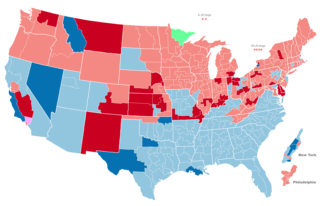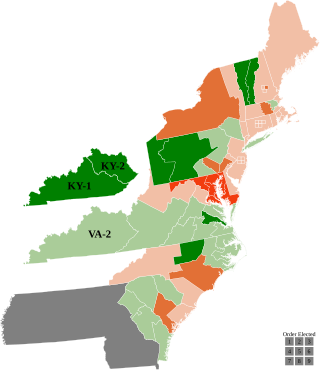
The 1918 United States House of Representatives elections were elections for the United States House of Representatives to elect members to serve in the 66th United States Congress. They were held for the most part on November 5, 1918, while Maine held theirs on September 9. They occurred in the middle of President Woodrow Wilson's second term.

The 1860–61 United States House of Representatives elections were held on various dates in various states between August 6, 1860, and October 24, 1861, before or after the first session of the 37th United States Congress convened on July 4, 1861. The number of House seats initially increased to 239 when California was apportioned an extra one, but these elections were affected by the outbreak of the American Civil War and resulted in over 56 vacancies.
The 1838–39 United States House of Representatives elections were held on various dates in various states between July 2, 1838, and November 5, 1839. Each state set its own date for its elections to the House of Representatives before the first session of the 26th United States Congress convened on December 2, 1839. They occurred during President Martin Van Buren's term. Elections were held for all 242 seats, representing 26 states.

The 1828–29 United States House of Representatives elections were held on various dates in various states between July 9, 1828, and October 5, 1829. Each state set its own date for its elections to the House of Representatives before the first session of the 21st United States Congress convened on December 7, 1829. Elections were held for all 213 seats, representing 24 states.

The 1794–95 United States House of Representatives elections were held on various dates in various states between August 25, 1794, and September 5, 1795 (Kentucky). Each state set its own date for its elections to the House of Representatives before the first session of the 4th United States Congress convened on December 7, 1795. They were held during President George Washington's second term. Elections were held for all 105 seats, representing 15 states.

The 1790–91 United States House of Representatives elections were held on various dates in various states between April 27, 1790, and October 11, 1791. Each state set its own date for its elections to the House of Representatives before or after the first session of the 2nd United States Congress convened on October 24, 1791. This was the first midterm election cycle, which took place in the middle of President George Washington's first term. The size of the House increased to 67 seats after the new state of Vermont elected its first representatives.

The 1812 United States House of Representatives elections in New York were held from December 15 to 17, 1812, to elect 27 U.S. Representatives to represent the State of New York in the United States House of Representatives of the 13th United States Congress. At the same time, a vacancy was filled in the 12th United States Congress.

The 1816 United States House of Representatives elections in New York were held from April 23 to 25, 1816, to elect 27 U.S. Representatives to represent the State of New York in the United States House of Representatives of the 15th United States Congress. At the same time, a vacancy was filled in the 14th United States Congress.

The 1826 United States House of Representatives elections in New York were held from November 6 to 8, 1826, to elect 34 U.S. Representatives to represent the State of New York in the United States House of Representatives of the 20th United States Congress.
Elections to the United States House of Representatives were held in Pennsylvania on October 14, 1828, for the 21st Congress. Members of three different parties were elected to the 21st Congress, the first time in US history that a third party won seats. The new Anti-Masonic Party won a total of 5 seats, 1 of which was in Pennsylvania.

A special election was held in North Carolina's 5th congressional district on August 8, 1805 to fill a vacancy left by the death of Representative James Gillespie (DR) on January 5, 1805, before the 9th Congress began, but after the general elections had taken place for the 8th Congress.

A special election was held in Pennsylvania's 1st congressional district on October 10, 1809, to fill a vacancy left by the resignation of Representative Benjamin Say (DR) in June of that year.

On April 20, 1824, Thomas J. Rogers (DR) of Pennsylvania's 8th district resigned, leaving a vacancy which was filled by a special election on October 12, 1824, the same day as the general election for the 19th Congress.

On December 15, 1829, a special election was held in Pennsylvania's 16th congressional district to fill a vacancy caused by the resignation of Representative-elect William Wilkins (AM) on November 9, 1829, prior to the start of the 21st Congress.

On October 11, 1836, a special election was held in Pennsylvania's 24th congressional district, to fill a vacancy left by the resignation of John Banks (AM) on April 2. This election was held at the same time as the general elections for the 25th Congress

On November 4, 1836, a special election was held in Pennsylvania's 13th congressional district to fill a vacancy left by the October 30th, 1836 resignation of Jesse Miller (J).

On June 29, 1837, a special election was held in Pennsylvania's 3rd congressional district to fill a vacancy left by the death of Francis J. Harper (D) on March 18, 1837.
A special election was held in Massachusetts's 14th congressional district to fill the vacancy left by George Thatcher (F) declining to serve a 7th term, having served continuously since the 1st Congress and, after the death of Thomas Hartley (F) in Pennsylvania's 8th congressional district on December 21, 1800, the last remaining member of the 1st Congress to have continuously served in the House. The election was held on June 22, 1801
A special election was held in Massachusetts's 12th congressional district on September 17, 1804, to fill a vacancy left by the resignation of Thomson J. Skinner (DR) on August 10, 1804

The 2022 Minnesota's 1st congressional district special election was a special election held on August 9, 2022. The seat became vacant when incumbent Republican representative Jim Hagedorn died on February 17, 2022, from kidney cancer.









